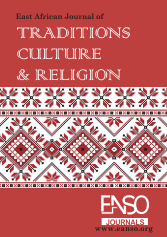The Effects of Adaptation of Circumcision Age Set System into the Lineage System of the Tigania in the Pre-Colonial Period Circa, 1850-1908
Abstract
The purpose of this study was to analyze the context of the adaptation of the circumcision age set system on the lineage system of the pre-colonial Tigania circa 1850s-1908. It investigated the cultural dynamics which resulted in the adoption of the circumcision age set system and how it adapted itself in a lineage society. Specifically, the study examined the effects of such adaptation on the social-cultural organization of the pre-colonial Tigania which was a predominantly lineage-based society. The research was interpreted within the theories of social structuralism and instrumentalism theories, which were used to analyze the functionality of the circumcision age set system and the impacts of circumcision age set adaptation by the pre-colonial Tigania. The study employed a descriptive research design. The study location was in Tigania, Meru County with a population of 316, 341 targeting the population with knowledge of the age set system. A sample size of 40 respondents aged 60 years and above based on the concept of data saturation was selected. This sample was selected from the target population through purposive and snowballing sampling procedures. The respondents at this age possessed less diluted information as they acquired it from their parents or grandparents on age-set adaptation. The study also collected data from individuals who were younger but seemed resourceful as a result of education and community leadership experience. The interview guide was used for data collection. Due to the nature and the scope of the study, the data was mainly collected from secondary and oral sources and then corroborated. The data collected was analyzed qualitatively and presented thematically. The research was carried out with strict adherence to the ethics of research. The study found out that when pre-colonial Tigania adopted circumcision the existing lineage system was significantly affected in such a way that, the age set system played a complementary role in pre-colonial Tigania. The age set system expanded the scope of social functions as it cut across the clan boundaries. The clans became more organized, stronger, and safer. Consequently, the adoption and adaptation of the circumcision age set by the pastoralists’ communities strengthened their clan system hence, their survival. This study sheds light on academia and society on how such cultural adaptations influenced the existing structures of the recipient African societies. Hence, contributes to knowledge of the social and cultural history of pre-colonial Tigania and explains how cultural adaptation in pre-colonial African societies unfolded.
Downloads
References
Ambler, C. (1988). Kenyan communities in the age of imperialism. Chelsea, Michigan: Book Crafter.
Bernardi, B. (1952).The age set of the Nilo-Hamitic peoples: A Critical Evaluation.Journal of the International African Institute, 22(4), 316-332
Bernadi, B. (1959). The Mugwe, A Falling Prophet. London: Oxford University Press.
Bernadi, B. (1985). Age class systems, social institutions and polities based on Age.Cambridge: Cambridge University Press.
Borg, W., & Gall, M. (1982). Educational research: An Introduction.4th Ed. New York: Longman.
Eisenst, S. (1954). African age groups: A comparative study. Journal of the International African Institute, 24(2), 100-113
Fadiman, J. (1993). Where we began, there were Witchmen: An Oral History from Mt. Kenya. Berkeley: University of California Press.
Glaser, B and Strauss A. (1967). The discovery of grounded theory: strategies for qualitative research
Goldsmith, P. (1994). Symbiosis and Transformation in Kenya’s Meru District. ADissertation presented to Graduate School of University of Florida for Degree of Philosophy.
Hollis, A. (1909). The Nandi: Their language and folklore. Oxford: Oxford University PressIcheria, K. (2015). Social narrative on Tharaka people in Kenya. International journal of humanities Social sciences and education (IJHSSE), Volume 2.
Kathuri, & Pals, (1993). Introduction to education research. Njoro, Egerton University: Educational Media Centre.
Keesing, R. (1981). Cultural Anthropology: A contemporary perspective. (2nd ed.) New York: Holt, Rinehart and Winston.
Kombo, K. and Tromp, L. (2006). Proposal and Thesis writing: an introduction. Nairobi: Nairobi Publications Africa.
Kothari, C. (1985). A research methodology, methods and techniques. New Delhi: Wiley Eastern Limited
Mahner, J. (1970). The outsider and the insider in Tigania Meru. Unpublished.
Mugenda, O., &Mugenda, A. (1999). Research methods and quantitative and qualitative approaches. Nairobi: Acts Press
Ndung’u et al. (2016). Generation sets as institutions of cohesion and mutual existence in pre colonial Kenya. Journal of humanities and social sciences, 4(9c):
Oso, W. and Onen, D. 2005. A General guide to writing research proposal and report. A book for beginning researchers (2nd ed.)
Parkin, R. (1997). Kinship. An introduction to basic concepts Blackwell, Oxford.
Rimita, D. (1988). The NjuriNcheke of Meru. Meru Kenya. Self-Published.
Robert, A., &Sangree, W. (1962). The diffusion of age group in East Africa: A controlled comparison. International African Institute, 32(2),
Sandberg, A. (1969). Generation conflict and entrepreneurship in Meru. Unpublished Paper Institute of Development Studies University of Nairobi.
Sangree, H. (1967). Age, prayer and politics of Tiriki.Nairobi: Oxford University Press.
Spear, T. (1981). An introduction to historical method in Africa. Longhorn Group Limited.
Wolf, J. (1980). The diffusion of age group organization in East Africa: A Reconsideration. Cambridge University Press.
Archival sources
KNADC/MRU/Annual Report, Meru District, 1937
KNADC/MRU/Annual Report, Meru District, 1955
Copyright (c) 2024 Igweta Dancan Ntongai, Martha Muraya, PhD

This work is licensed under a Creative Commons Attribution 4.0 International License.




























